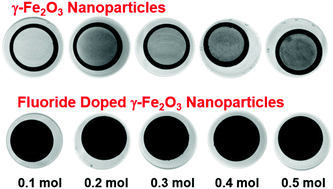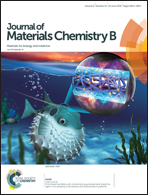Fluoride doped γ-Fe2O3 nanoparticles with increased MRI relaxivity
Abstract
Iron oxide nanoparticles (IONs) are being actively researched and experimented with as contrast agents for Magnetic Resonance Imaging (MRI), as well as image-directed delivery of therapeutics. The efficiency of an MRI contrast agent can be described by its longitudinal and transverse relaxivities, r1 and r2. γ-Fe2O3 nanoparticles – doped with fluoride in a controlled manner and functionalised with citric acid – showed a 3-fold increase in r1 and a 17-fold increase in r2 in a magnetic field of 3 T and almost 6-fold increase in r1 and a 14-fold increase in r2 at 11 T. Following fluorination, PXRD shows that the crystal structure of γ-Fe2O3 is maintained, Mössbauer spectroscopy shows that the oxidation state of the Fe cation is unchanged and HREM shows that the particle size does not vary. However, magnetisation curves show a large increase in the coercive field, pointing towards a large increase in the magnetic anisotropy for the fluorinated nanoparticles compared to the un-doped γ-Fe2O3 nanoparticles. Therefore, a chemically induced increase in magnetic anisotropy appears to be the most relevant parameter responsible for the large increase in relaxivity for γ-Fe2O3 nanoparticles.



 Please wait while we load your content...
Please wait while we load your content...